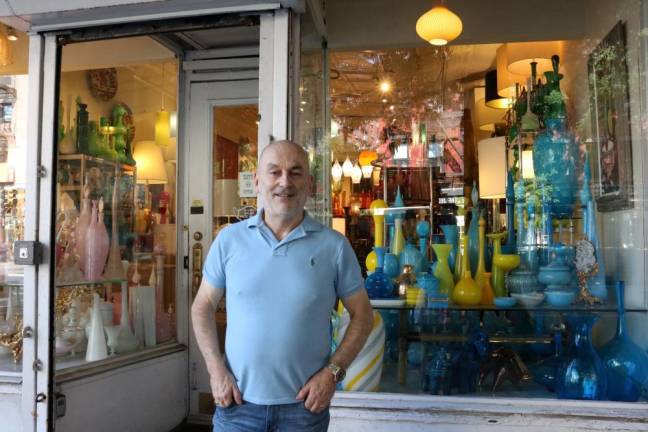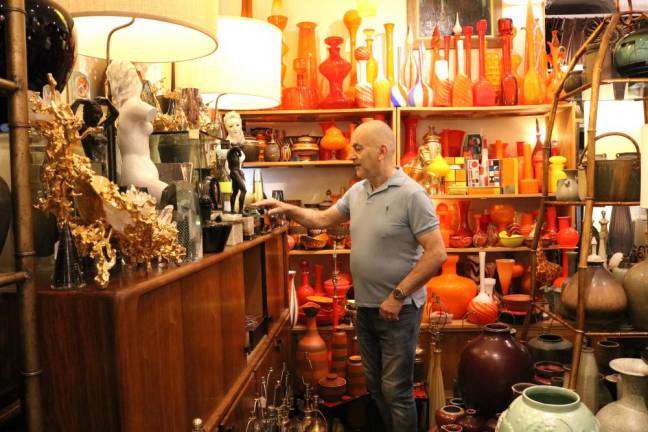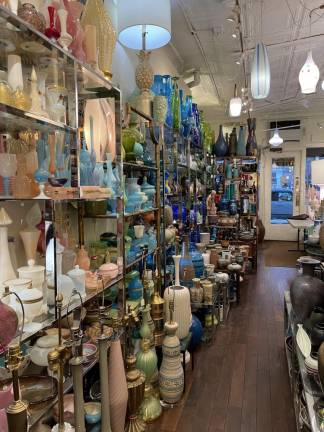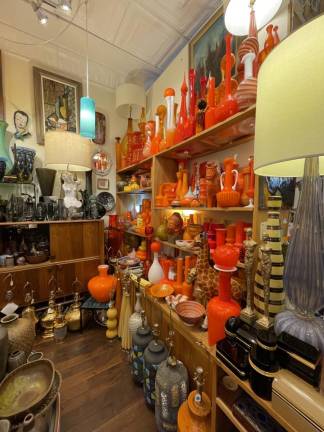Boy Meets Vase, and the Rest is History
Antique dealer Stephen Saunders soared through lockdown from the comfort of his West Village shop




About 53 years ago, an auctioneer held up a blue-and-white, Chinese porcelain vase as he sold off the contents of an English country house. Among the buyers in the front yard sat an antique dealer and his kid nephew, Stephen Saunders. The boy begged his uncle to bid on the vase; he loved the vase. But the man refused — he had eyes only for the furniture. The Americans want the furniture, he assured his young companion.
“In my little 10-year-old brain, I said to myself, ‘Well I’m bloody well going to have a shop full of vases one day,” a grownup Saunders remembers, sitting behind a desk in his West Village store, The End of History. “And this is literally the culmination of that.”
In one front window of Saunders’ store, an army of tall blush- and rose-colored vases line up in rows, their rounded, pointed, and open tops peeking out behind each other. Dotted between them are gold-accented vessels in pearlescent shades of white and creamy carnation. Inside, shelves stacked with glassware organized by color tower over customers as soon as they enter. For those who cannot afford the steep prices, it is pure eye candy. For the professional decorators and patrons who aim to bring something home, it’s a wonderland of possibilities.
“The End of History is like a groovy hip museum where you can actually buy stuff. Imagine going into the V and A in London and being able to buy the objects on display,” says writer and fashion creative Simon Doonan via email. “Stephen has a magical ability to present an astonishing amount of objects without overwhelming the customer. He is a great art director.”
Saunders sees his store as a scrappy survivor: of 9/11, the economic collapse of 2008, a building fire in 2009, Hurricane Sandy, and now COVID. In fact, the pandemic has worked in his favor “in a weird, weird, weird way.” He says 2021 was his most profitable year. “It’s actually directly attributable to the pandemic. One of the categories that did really well in the pandemic was housewares, from my luxury things all the way down to like $20 things on Amazon.”
He didn’t expect the boom in business. But Saunders discovered that in the face of stay-at-home orders, people picked up their phones, called their decorators, and sent them to The End of History. “We’d leave the door open for air, and wear masks and everything,” Saunders remembers of his meetings with home designers. “Even when we were supposed to be locked down and not open, I would sneak in private appointments. I don’t know whether it was legal or not.”
Auction Sites and Flea Markets
As a child growing up on the Isle of Wight, just off the southern coast of England, Saunders was happily thrust into the antiquing world, exploring auction sites and flea markets before he could walk. While most of Saunders’ family was involved in art, his father owned the now-discontinued local paper, The Shanklin Chronicle and Guardian. “He would run an ad for me every week that said, ‘Local collector seeks blah, blah, blah, blah, blah, blah.’ And then he’d take me around and we’d buy things from people and then take them up to London,” Saunders recalls. “By the time I was 12, I was selling things at Sotheby’s.”
Saunders’ journey to The End of History took him through a whirlwind of careers. He worked as a travel agent in London and in Hawaii, and came to New York in 1983 to work as a stylist. In the background, though, he was always buying and selling antique items. He frequented the Chelsea Flea Market during its heyday. There, he had a “lightbulb moment.”
It was Murano glass in orange, Saunders’ favorite color, that set the ball rolling towards The End of History. “This guy offered me a piece that had a Bonwit Teller price tag on it,” he remembers. The original price was $300. “I was like, ‘Wait a minute, this guy’s selling this to me for $25 now.’ So I literally started to buy every piece I could. I filled up a warehouse with these kinds of things.”
The dreams of Saunders, in youth and in maturity, became reality in 1997, when he opened The End of History on Hudson Street. Back then, he says, it was the “cheapest place in downtown Manhattan to rent a shop.”
Glittering vases, lamp stands, and miscellaneous mid-century vessels inspire visions of the open sea on one wall, with countless shades of cobalt, turquoise, and cerulean almost touching the ceiling. Saunders considered arranging the store like a museum, organizing his inventory based on country or by designer. However this wouldn’t have served the purposes of his clientele. “When an interior designer goes into fabric shop, they want to see velvet in every color. When they come in here, they want to see vases in every color. If you want orange, you come to this section. And you might have an Italian piece next to a Danish piece next to a Swedish piece.”
This, according to Gideon Mendelson, the head of design firm Mendelson Group Inc., is precisely what a decorator needs when adding the finishing touches to a space. “I think what’s great is you can go there with a good amount of knowledge and have a lot of success,” says Mendelson, who has known Saunders for 20 years. “Or you can just go there and know nothing, and come out of there feeling like you want to start collecting something.”
“Jewelry for the Home”
Almost everything Saunders sells is decorative; there isn’t a single teapot or dining plate in the store. He affectionally dubs his inventory “jewelry for the home.” His glassware and ceramics provide the finishing touches in the final stages of decorating. “When all the rugs are down, when all the furniture is ordered, when every surface has been painted, polished, and buffed, then they come in with the vases and stuff like that,” says Saunders. “It’s like when you’re going out for the evening and have an evening gown on, the last thing you put on is the jewelry. It’s the same for the home.”
“My experience with Stephen is he sets up a little table for me there, and I start pulling things. And he gives me the space that I need, because I sort of style on my own,” says Mendelson. “But ... he’s got great taste, and he’ll always find something that I’m not looking at. And it might just be the sort of unusual thing that gives the space exactly what it needs.”
The store features items from all around the world, focusing especially on the mid-century style. Saunders is most drawn to post-war Italian pieces, though he says there’s not a drop of Italian blood in his body. “It’s the same thing that drives you to Italian food, it’s just the absolute deliciousness and uniqueness of it. The Italians are special.”
“We Like Stuff”
The End of History came about during “a sort of fascist regime of decorating,” says the owner. Nineties home decor ran strictly by the rule of less is more. “You must not have color. You must not have knickknacks. You can’t have anything. You’ve got to be minimalist. Clean surfaces,” says Saunders, imitating the dictators of last century’s trends. “Well it turns out people were sick of that by ’97. Just sick of it. I came at the right time. I gave people permission to say, ‘Look, we like stuff. It’s okay to have stuff.’”
Saunders, a self-proclaimed, “full-on” maximalist, lives by the freedom to love stuff. His Chelsea apartment is bulging with his favorite items. There’s more of a depth of age in his apartment, he says, with several 19th-century pieces, organized by form and his personal tastes. Saunders’ husband of 17 years, an accountant, never gave much thought to vases before the two met. He appreciates the extravagance nonetheless.
So does longtime friend and renowned decorator Jonathan Adler: “Stephen Saunders is doing God’s work. He is curating and archiving all the most beautifully designed objects that have ever been produced and representing them to the general public. I am a huge fan,” he said in an email.
Saunders has taken to Instagram to serve a wider public during Covid times. The End of History’s page (@theendofhistory) is as jammed with beauty as the store itself. He communicates with interested buyers via direct message, where he’ll pass along measurements and pricing information. None of the prices are public to followers.
What’s most important to Saunders is his individuality as a collector. Unlike most antique dealers, he is not — nor will he ever be, he vows— a member of any large-scale online marketplaces. “They just swallow you up ... I’m going to be the last freestanding, independent antique shop in New York City.”
Saunders’ husband, who is much younger than himself, plans to honor his partner’s obsession forever. “I said to him, ‘You know, when I die this stuff is worth a lot of money, you’ll be able to sell it,’” Saunders recounts with a chuckle. “And he said, ‘I’m not touching anything!’ He said it will be a shrine.”
“One of the categories that did really well in the pandemic was housewares, from my luxury things all the way down to like $20 things on Amazon.” Stephen Saunders of The End of History